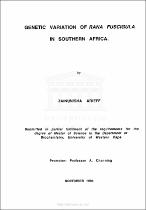| dc.contributor.advisor | Channing, Alan | |
| dc.contributor.author | Arieff, Zainunisha | |
| dc.date.accessioned | 2023-06-12T11:52:32Z | |
| dc.date.available | 2023-06-12T11:52:32Z | |
| dc.date.issued | 1994 | |
| dc.identifier.uri | http://hdl.handle.net/11394/10144 | |
| dc.description | >Magister Scientiae - MSc | en_US |
| dc.description.abstract | Naturalists have long been engaged in describing and explaining diversity in the biological world. The discovery of the molecular basis of inheritance has led to rapid increase in the use of biological macromolecules in these investigations. Scientists now routinely investigate the DNA of a range of organisms. The elationships between taxa and the phylogeny of groups is determined by examining the differences and similarities between them. These differences are then appropriately analyzed. lt is important to understand the natural variation within a group, before the differences between groups can be established. This study aims to determine the molecular differences between individuals at the extreme edges of the distribution of a species. This will serve as a molecular baseline, from which other studies can proceed. The experimental species is the trog Rana fuscigula, which has a range restricted to southern Namibia and South Africa. lt was thus possible to collect material from the edge of the distribution assuming that maximum genetic
difference would be found between individuals at the edge of the range | en_US |
| dc.language.iso | en | en_US |
| dc.publisher | University of the Western Cape | en_US |
| dc.subject | Deoxyadenosine triphosphate | en_US |
| dc.subject | Deoxyribonucleic acid | en_US |
| dc.subject | Micro Curie | en_US |
| dc.subject | Ribosomal deoryribonucleic acid | en_US |
| dc.subject | Nontranscribed spacer | en_US |
| dc.title | Genetic variation of rana fuscigula in Southern Africa | en_US |
| dc.type | Thesis | en_US |
| dc.rights.holder | University of the Western Cape | en_US |

